The Future of Apple's Smartphone Launches and Trends
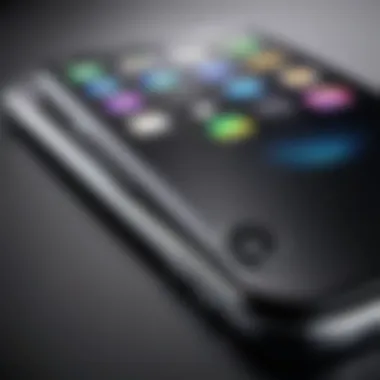
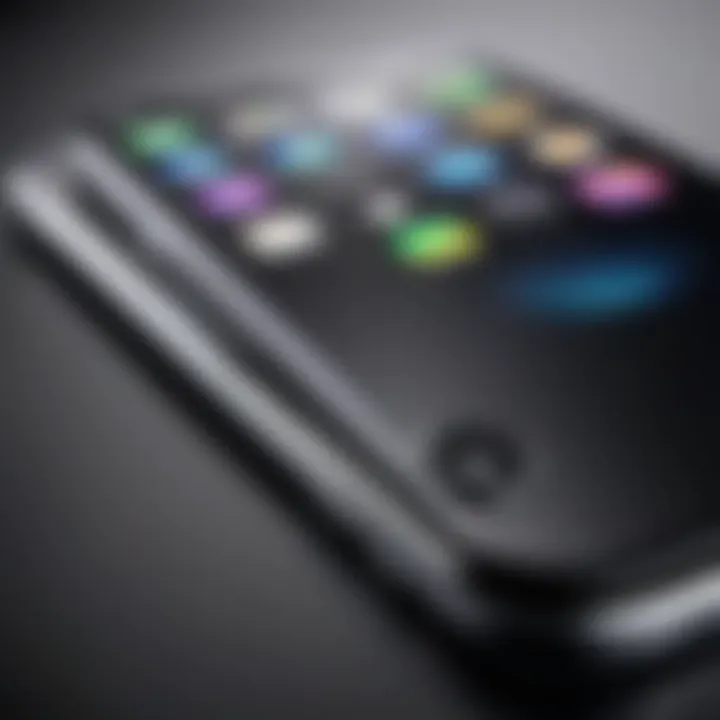
Intro
In recent years, Apple has managed to carve out not just a technological niche but a significant cultural impact through its smartphone launches. Each new release becomes a talking point, creating a buzz that often overshadows competitors. Understanding the factors behind these launches is vital for enthusiasts and industry watchers alike. This quality article will delve into the tech advancements, shifts in market dynamics, and how Apple maintains its leadership position through strategic decisions. Expect to explore the latest features of their smartphones, market response, and how these elements work together to advance consumer expectations.
Overview of the Technology
Key Specifications
When a new iPhone hits the market, the tech community goes on high alert. Apple tends to push the envelope with specifications that are tailored to both power users and everyday consumers. For example, the iPhone 14 Pro Max features Apple's new A16 Bionic chip, which practically screams speed and efficiency. This chip doesn’t just process commands at lightning speed; it also enhances battery life and performance for demanding applications like gaming and video editing.
- Display: The 6.7-inch Super Retina XDR display offers vivid colors and deep blacks, making it ideal for streaming and gaming.
- Camera: With its triple-camera system, including a 48 MP main shooter, it musters enough photography prowess to make even novice photographers look like pros.
- Battery Life: The newer models boast up to 29 hours of talk time, which is a significant leap compared to earlier iterations.
Unique Selling Points
Apple’s smartphones are built on unique attributes that set them apart from competitors. The seamless iOS ecosystem is perhaps the most prominent feature. When you pair an iPhone with other Apple devices, like the Apple Watch or MacBook, the experience is both unified and effortless. Moreover, Apple’s commitment to privacy standards adds another layer of appeal which resonates strongly with a growing segment of consumers.
- Ecosystem Integration: Users can seamlessly share files through AirDrop or access their photos across devices with iCloud.
- Increased Privacy and Security: Features like Face ID and app tracking transparency enhance user trust in the brand.
- Customer Support: Apple's customer service is often lauded for being easily accessible.
"Apple's smartphones are not just devices; they're part of a lifestyle that promotes connectivity and security."
Design and Build Quality
Material Used
One glance at the latest iPhone and you might be captivated by its sleek design. Constructed from surgical-grade stainless steel and glass, each model feels premium in the hand. Apple's choice of materials not only contributes to aesthetics but also performance. The glass is reinforced, making it resistant to scratches and everyday wear that can make lesser devices fade.
Ergonomics and Usability
A significant aspect of Apple's design philosophy revolves around usability. The smartphone comfortably fits in the hand, making it easy for consumers to navigate through various applications. The positioning of buttons and the inclusion of features like haptic feedback enhance the overall experience. Ideally, whether you are scrolling through social media or taking a high-resolution photo, the actions feel natural and intuitive.
Emphasizing comfort, the fluid gestures in the latest iOS versions make the navigation less reliant on buttons.
In a fast-paced tech world, understanding the significance of Apple's smartphone launches is crucial. This article aims to unravel the overlapping narratives of technology adoption, consumer behavior, and strategic positioning as they relate to Apple’s ever-evolving landscape.
Prelude to Apple's Smartphone Launch
The smartphone launch event by Apple isn’t merely a date marked on the calendar; it acts as the bellwether for trends and innovation in technology. These events not only generate buzz but also serve as a critical juncture in which the expectations of consumers are aligned with what tech enthusiasts, and early adopters perceive as market advancements. As phones have evolved from basic communication tools to powerful mini-computers, Apple’s launches have often set the tone of the industry’s trajectory.
In this article, we delve into what these launches mean for consumers and the market as a whole. Key aspects worth keeping in mind include the intricate balance Apple maintains between technological advancements and consumer expectations. Assessing these launches helps one understand broader implications – not just for Apple, but for the mobile technology landscape at large.
The Evolution of Apple's Mobile Devices
The journey of Apple’s mobile phones is a fascinating evolution. From the original iPhone, which was launched in 2007, to the sophisticated models available today, each iteration reflects not just technological advancements but also shifts in consumer preferences. Initially, the concept of a smartphone was more about a functional device for calls and texts. As Apple introduced features like the App Store and a robust camera system, they began redefining the boundaries of what users could expect from mobile devices.
Today, Apple’s line-up caters to a diverse range of needs – from high-end models like the iPhone 14 Pro Max to more budget-friendly options like the iPhone SE. With each launch, there’s a visible attempt to cater to an audience looking for either sophisticated technology or usability without breaking the bank.
"The essence of Apple’s success in smartphone evolution lies in its ability to intuitively meet the needs of its users while staying ahead of competitors."
Significance of Launch Events
When Apple announces a new device, it creates waves throughout the tech community and beyond. These launch events are filled with anticipation and excitement, almost akin to an annual ritual for tech lovers around the globe. The significance of these events extends beyond mere product unveiling. They are pivotal moments that mark strategic shifts in the company’s operations and reinforce Apple’s status as an industry leader.
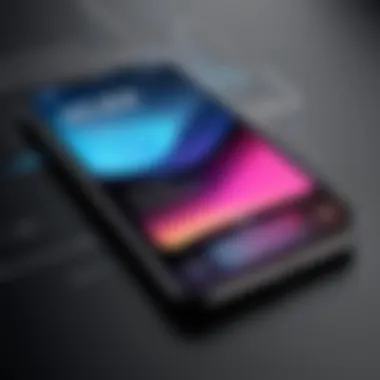
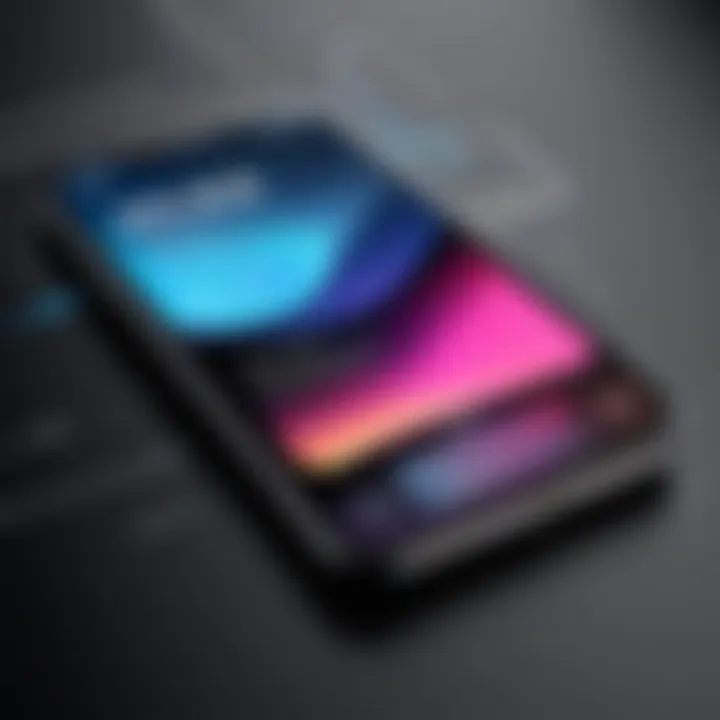
Various factors contribute to why these launches are important:
- Market Trends: Trends in consumer behavior can often be assessed based on the reception of new devices. For instance, a surge in interest for 5G compatibility among consumers was met with the timely introduction of models featuring that capability.
- Brand Loyalty: Launches can also reaffirm brand loyalty. A customer who purchases a new iPhone is likely to remain an Apple user, influenced by the ecosystem that the company creates – iCloud, Apple Music, and so on.
- Media Attention: The global media spotlight during these events amplifies the significance, as news outlets and social media platforms discuss the implications of the new features, thereby influencing consumer perception and desirability.
The conscious orchestration around these events, encompassing strategic product promotions and marketing campaigns, underlines their centrality in Apple’s overall business strategy. As a cornerstone of Apple's product cycle, every launch offers a wealth of insights and reveals broader market dynamics that are crucial for both consumers and industry observers.
Technological Advancements in the Latest Model
The realm of smartphones changes faster than the blink of an eye. For Apple, keeping pace means more than just incremental updates; it’s about making bold strides in technology that enhance user experience. These advancements not only elevate the device's functionality but also impact how consumers perceive the brand and its commitment to innovation. Indeed, a smartphone is more than just a product; it’s a statement of lifestyle, and Apple's endeavor to lead the charge in this arena is evident in their latest model.
Key Features and Specifications
The latest smartphone boom from Apple isn't just a flash in the pan; it's packed with features that make users sit up and take notice. At the heart of it all is an impressive set of specifications. For instance, the new model boasts a stunning retina display that provides clearer images with richer colors. Moreover, Apple has outdone itself with the A-series chip, granting not just remarkable processing power, but also energy efficiency that's kinder to the battery.
Consider also the storage configurations; these devices are available with options reaching upwards of 1TB, letting users store an impressive library of apps, photos, and videos. The simplicity of the device doesn’t just mask complexities beneath the surface but actively incorporates premium materials, ensuring that the phone feels as great as it performs.
Innovations in Camera Technology
In today's visual-centric society, the camera quality of a smartphone often serves as the juggernaut that drives its popularity. With Apple’s latest launch, camera technology has transcended typical smartphone capabilities. The introduction of computational photography offers functionalities which can amplify low-light performance, enhance depth perception, and even suggest the ideal settings for a scene.
One notable feature is the Cinematic Mode, which permits users to shoot videos with a real film-like quality. It can change focus dynamically and offers beautiful bokeh effects, making skills that once seemed solely reserved for professional videographers accessible to the everyday user. With these innovations, Apple isn't just keeping up with consumer demand; it's setting new industry benchmarks.
Performance Enhancements and Chips
Under the hood, the magic continues. The new A16 Bionic chip is more than a mere update. With its specially designed architecture, it allows heavy tasks—like playing high-end games or multitasking without lag—to run smoothly. This chip significantly improves overall speed and enhances graphics performance without draining battery life at a troublesome rate. In addition, improved machine learning capabilities tailor experiences uniquely, foreseeing user preferences and adapting accordingly.
Apple is also tapping into the realm of 5G connectivity, ensuring that users experience low latency and fast download speeds while rendering cloud-based tasks seamless. The chip’s ability to optimize data usage and preserve battery life while maintaining high performance emphasizes Apple’s commitment to future-proofing their devices.
"Technology advancement isn't merely about upgrades; it’s about redefining the user experience and pushing boundaries in communication."
Overall, the importance of these technological advancements in Apple's newest smartphone cannot be overstated. They not only heighten user engagement but also fundamentally alter the way phones are perceived in everyday life. In this new era of smartphone launches, Apple continues to position itself as a pioneer, leading first and foremost with innovation.
Design Elements and User Experience
In the fast-paced realm of smartphones, design and user experience are not merely aesthetic choices; they are the heartbeat of how consumers perceive and interact with their devices. For Apple, in particular, these elements intertwine to create a seamless blend of form and function, often setting the tone in the technology market. Touch points here are numerous, encompassing visual appeal, tactile feedback, and intuitive navigation, each contributing to a holistic user experience. The design language Apple is known for, such as minimalism, greatly influences brand loyalty and acts as a measure of innovation.
Design Philosophy and Aesthetics
When we talk about Apple's design philosophy, we can't avoid mentioning Jonathan Ive's influence from the past. The overarching objective has consistently been to strip down unnecessary components to unveil an elegant and simple device. This ideology goes well beyond mere looks. It addresses the emotional connection users develop with their smartphones. A classic example is the iPhone's sleek lines and gentle curves, which not only enhance aesthetic appeal, but also improve ergonomics, making the device comfortable to hold for extended periods.
The aesthetics of a product is often what catches the eye first. It's like dressing a beautifully tailored suit; the right fabric can speak volumes about a person’s taste. Apple's meticulous attention to detail ensures that even the smallest aspect, like the finish on the aluminum casing, exudes a premium feel. In today's market, with tech companies racing to outdo each other, this design philosophy becomes a strong differentiator.
The Role of Material and Build Quality
Materials play a crucial role in the overall experience of using Apple’s devices. The latest models, such as the iPhone 14 series, feature ceramic shield front covers and aerospace-grade aluminum enclosures. These choices are not merely for show; they signify durability. Users expect their devices to withstand daily wear, and Apple aims to meet those expectations head-on.
There's a reason many tech lovers place a premium on build quality. It reflects longevity and helps maintain performance over time. For instance, while other brands may opt for lighter plastics, Apple's commitment to using high-quality materials ensures that their smartphones resist scratches and breaks. It's a point that resonates with environmentally conscious consumers, too, as they often associate quality materials with sustainability.
User Interface Improvements
Just as vital as design and materials are the user interface (UI) improvements that Apple incorporates into its devices. The recent iterations have emphasized simplicity, making advanced tech accessible to the masses. This is particularly visible in the overhaul of iOS design with features like a customizable home screen and more intuitive app organization. Whether it’s optimizing gestures or streamlining navigation, Apple’s focus remains on fostering an effortless user dialogue with their devices.
These improvements aren't just cosmetic; they fundamentally alter how users interact with their devices.


"The ultimate goal of user experience design is to make the user's interaction as simple and efficient as possible."
Consider the way notifications are displayed. They are no longer just a cluttered list; they are contextual and actionable, allowing users to process information quickly without getting bogged down. Consequently, this fluidity in UI leads to a more engaging user experience overall, inviting deeper engagement with the device and, ultimately, contributing to customer loyalty.
Market Trends Influencing Apple’s Strategy
In the fast-paced world of technology, market trends act as the compass guiding companies in refining their strategies. For Apple, understanding these trends is essential to maintain its prominence in the crowded smartphone landscape. The competition is not just about product features anymore; it encompasses a slew of variables from consumer preferences, economic conditions, to the environmental consciousness shaping buying decisions. Each of these elements plays a crucial role in how Apple navigates its smartphone launches and positions itself in the marketplace.
Comparative Analysis with Competitors
To grasp the gravity of Apple's position, it’s vital to consider the rivalry with other brands such as Samsung, Google, and OnePlus. Each of these manufacturers has its unique selling propositions and pricing strategies. For instance, while Samsung focuses heavily on the camera capabilities of their Galaxy series, consistently introducing advanced photographic features, Apple has traditionally centered its marketing on the ecosystem and user experience.
When it comes to market share, the dynamics can shift. Last year's analysis showed that Samsung held a firm grip on the Android smartphone segment, challenging Apple's grip within premium markets. This rivalry compels Apple to continuously innovate—not just in hardware but also in software and ecosystem integration.
"In a market where consumer choices are broadened and technology evolves exponentially, staying ahead means constantly reassessing one's position against competitors."
Components such as the chipset performance, battery life, and even features like 5G connectivity have become battlegrounds for competitive analysis. In essence, each new release is a response not merely to internal aspirations but as an answer to the landscape shaped by competitors.
Consumer Trends and Preferences
Consumer behavior hasn’t remained stagnant; it’s been evolving in unpredictable ways. Today's smartphone users expect more than just shiny hardware. They seek personalization, seamless integration with other devices, and sustainability. A significant movement towards greener products has emerged where consumers are now more conscious of the environmental footprint of their purchases.
This shift leads Apple to not only enhance their product's lifespan through software updates but also to explore usage of recycled materials. The sustainability narrative resonates well with consumers, and it’s a trend that Apple has leaned into, committing to environmentally-responsible practices across product lifecycles.
One notable trend is the increasing demand for privacy-focused features. With more consumers becoming aware of digital security, Apple is capitalizing on this trend by embedding robust privacy features in its newest models, setting them apart from competitors. In today's landscape, marketing a device has transformed into a dual promise of technological prowess and ethical responsibility.
Incorporating these elements into product development helps Apple stay relevant, ensuring that each launch resonates with the expectations of its discerning audience. Addressing these preferences not only secures sales but also solidifies long-term loyalty among customers who value technological sophistication whilst advocating for sustainable practices.
The Role of Sustainability in New Releases
In today's world, sustainability isn’t just a buzzword; it’s a game changer. Companies, especially in tech, are increasingly being held accountable for their environmental footprints. The shift towards sustainable practices is particularly crucial for Apple, a brand that has long associated itself with innovation and quality. In this section, we'll see how Apple's commitment to sustainability impacts not just its product lines but also sets a standard in the tech industry. The push towards greener products is seen as an essential move.
Apple's Commitment to Environmental Responsibility
Apple has pledged to become carbon neutral by 2030 across its entire supply chain. This ambitious goal doesn’t stop at manufacturing; it extends to the materials used, the energy consumed, and, ultimately, the longevity of its products. By 2023, the company reported significant achievements in recycling, using recycled materials, and reducing emissions.
Apple stands firm in the belief that embracing sustainability isn’t merely for compliance; rather, it’s about setting a precedent. By focusing on lowering its carbon footprint, it attempts to lead by example. If Apple can manage to incorporate its dedication to environmental responsibility into its narrative, it will be more than just a marketing strategy; it will be a movement helping to shift consumer preferences towards greener options.
Materials and Manufacturing Practices
The materials and manufacturing processes utilized in Apple's devices are undergoing significant transformations, reflective of their commitment to environmental stewardship. The company strives to use sustainable materials, like recycled aluminum and rare earth elements, which lessens the need for mining virgin materials. The advantages of this approach are twofold: not only does it reduce waste, but it also helps conserve finite resources.
Moreover, Apple’s manufacturing facilities are being upgraded to utilize renewable energy, significantly cutting down their carbon emissions. They work closely with suppliers to ensure that their practices conform to high environmental standards. For instance, many of Apple's suppliers are encouraged to adopt clean energy solutions, which ultimately creates a ripple effect across the industry.
Here’s a quick overview of how Apple approaches sustainability in manufacturing:
- Recycling Programs: Apple has implemented robust recycling programs that allow users to return their old devices, which helps recover materials for new products.
- Renewable Energy: By 2023, Apple reported that 100% of its corporate operations are powered by renewable energy.
- Supplier Responsibility: The company offers training and resources to suppliers to help them transition to sustainable practices as well.
"To reduce our dependency on raw materials, we aim to create a closed-loop supply chain, where we reuse materials from old devices to create new ones." - Apple CEO, Tim Cook
In summary, Apple's shift towards sustainability in new releases encapsulates a broader commitment not only to its products but to the planet. A sustainable approach resonates deeply with today's consumers, who increasingly prefer companies advocating environmental responsibility. For Apple, the journey might still be in its early stages, but the strides they are making, both in materials and manufacturing, represents a noteworthy change in the tech landscape.
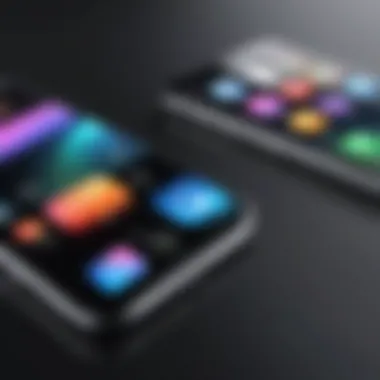
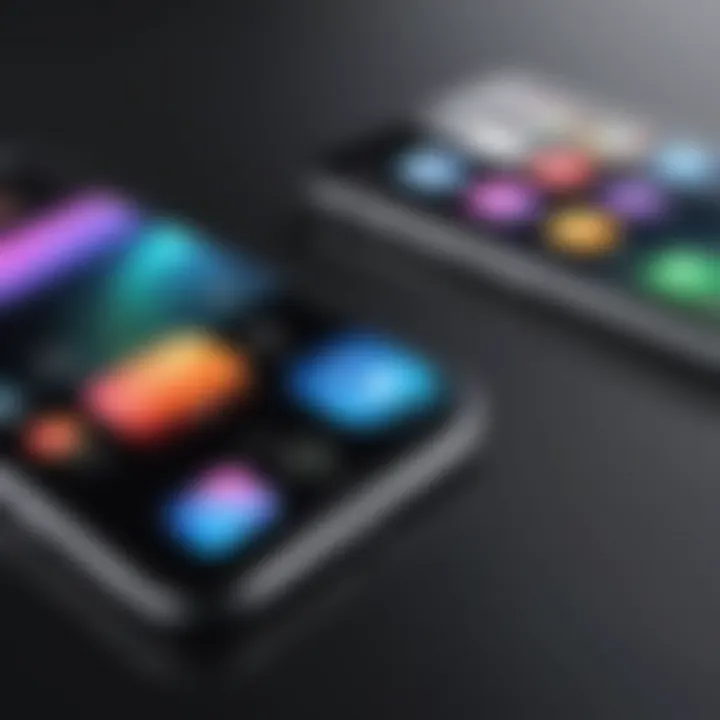
Consumer Expectations and Reactions
In the ever-evolving world of smartphones, consumer expectations are crucial. They are not just the whispers of the crowd but the drumbeats guiding a company's strategy, especially for a giant like Apple. Each launch day is cloaked in excitement, and what consumers anticipate can shape the future of the market itself. As Apple maneuvers through the tech landscape, understanding these expectations and reactions becomes more vital than ever.
Anticipation Leading up to the Launch
The buildup to an Apple smartphone launch is something akin to the spectacle of a magician's grand reveal. Prior to the unveiling of each new model, there’s a palpable energy in the air. Rumors fly like confetti, fuelled by leaks from sources both known and obscure. The tech-savvy crowd scours websites, digging for hidden clues or insights that might hint at design shifts or revolutionary features.
Apple understands this dance well. Their marketing strategies lean heavily into creating anticipation. This isn't merely about revealing a product; it's about crafting a narrative that captivates the audience's imagination. For instance, teaser campaigns often drop enigmatic clues months in advance, offering glimpses that pique curiosity without giving anything away. Some consumers even hold back on purchasing other brands, waiting with bated breath for the next iPhone to hit the shelves.
Moreover, the date itself of the launch event becomes almost sacred. Tech enthusiasts mark their calendars, planning their days around the keynote. This anticipation spirals into heightened expectations. There's a shared community experience, where online forums like Reddit become arenas of speculation. When new features are announced, a sense of accomplishment envelops those who predicted them correctly. It's a thrilling roller coaster ride that keeps the audience glued tight.
Initial Feedback and Reception Post-Launch
Once the excitement culminates and Apple finally pulls back the curtain, the reception of their new smartphone can be a mixed bag. In the immediate aftermath of a launch, social media platforms are littered with reviews, opinions, and the inevitable comparisons to previous models. It's like opening the floodgates; everyone clamors to share their thoughts.
Feedback often comes in waves. Initial responses usually flow from early adopters—those who queued up at the crack of dawn to be among the first to cradle the new device. These individuals tend to celebrate new features and unexpected innovations, sharing unboxing videos that go viral almost overnight. Descriptions fly around about the impressive camera upgrades or the responsiveness of the new chip. However, this initial enthusiasm can mask deeper issues that emerge later.
As the dust settles, a broader audience begins to weigh in. This feedback from average consumers often edges toward reality—the quirks, the software bugs, and the all-too-frequent issues that sometimes shadow new launches. Tech reviewers dissect every facet of the product, and the conversation shifts from excitement to critical analysis. Social platforms buzz with discussions on battery life, software glitches, user interface changes, and more.
"Every Apple launch is a momentous occasion, but the true test lies in user experience post-launch."
This evolving dialogue is crucial. Apple takes note of these reactions, often adjusting their customer service responses or planning future updates based on what users say. In the high-stakes game of tech, knowing what resonates with consumers, and what doesn't, can make or break the next iteration.
In summary, the anticipation leading up to an Apple launch and the initial feedback it generates plays an intertwining role in shaping consumer perceptions not just of the product but of Apple's brand itself. With each cycle of anticipation and reaction, Apple not only learns but recalibrates its trajectory in the competitive smartphone arena.
Implications for Future Innovations
The landscape of smartphone technology is rapidly evolving, and Apple is often at the forefront of this transformation. Understanding the implications of their smartphone launches is crucial, as these events are not just product reveals; they represent a confluence of innovation, market strategy, and consumer sentiment that shapes the technology ecosystem undoubtedly. Apple’s approach not only influences their product line but also sets a precedent that competitors feel compelled to follow.
The significance of Apple’s new innovations stretches beyond the immediate features unveiled. It encapsulates broader market dynamics, managerial decisions, and consumer expectations that could shift the entire industry's trajectory. From the incorporation of new sensors in their devices to enhancing AI capabilities, the ramifications of Apple's decision-making can inspire or reorient technological advancements across the board.
Long-term Impact on Technological Development
Apple's choices around technological innovations often act as a catalyst for larger industry advancements. Their developments in privacy features, biometric security, or battery longevity compel competitors to invest in similar or superior technologies.
This competitive pressure promotes a cycle of innovation fueled by consumer demand. As consumers become more educated on both product capabilities and privacy issues, the response from tech companies is quick and often substantial. For instance, when Apple introduced the Face ID technology, it not only reshaped their security features but also provoked a reevaluation of biometric authentication across various devices produced by other companies. The long-term impacts can often result in whole new areas of research and development, as well as shifts in corporate investments toward emerging technologies.
- Enhanced security features, like Face ID, push others to innovate in authentication technology.
- Competitive pressure encourages improvements in battery technology and backup features.
- Greater emphasis on user privacy ignites a broader industry dialogue on data usage.
Predictions for the Next Generation of Devices
As the future of smartphones comes into perspective, one cannot overlook the likely advancements we might witness. Consumers are becoming more vocal about their needs, and technology is adapting rapidly to meet these demands. Observing current trends, we can expect:
- Foldable devices: Apple is rumored to be investing in foldable technologies, responding to competitors’ successful launches. The move could redefine portability and user interface design.
- Augmented Reality Integration: With the rise of AR applications, Apple may continue to integrate more AR capabilities directly into their devices, enhancing user experiences and interactions.
- Advanced AI features: Future generations of iPhones may include more powerful on-device AI processors that can provide personalized user experiences while ensuring privacy.
- Sustainability-focused innovations: Apple's commitment to reducing its environmental footprint will likely lead to smart features that optimize energy use, thus promoting both efficiency and eco-friendliness.
The potential paths forward are not merely hypothetical; they hinge on what Apple will reveal in forthcoming launches and how they pivot in response to consumer feedback and market trends. As the tech world watches, the ripple effects of Apple's innovations will undoubtedly be felt well into the next decade.
Culmination
The conclusion serves as a critical capstone to this exploration of Apple’s smartphone launch dynamics. It ties together the various threads discussed in the article and emphasizes the importance of understanding how Apple influences not just smartphone technology, but the entire tech landscape. With each new device, Apple doesn’t merely introduce another product; it shapes consumer expectations, pushes competitors to elevate their game, and often sets the standard for innovation.
Summarizing Apple’s Impact on the Tech Landscape
Apple’s footprint in the technology realm is difficult to overstate. The company has consistently managed to blend cutting-edge technology with seamless user experience, making it a benchmark in the industry. Here are a few key points highlighting Apple’s impact:
- Innovation Cycles: With every smartphone release, Apple unveils features that other brands often scramble to replicate. This innovation drives technology forward.
- Consumer Behavior Influencer: Apple is not just a player in the market; it shapes consumer desires. The anticipation surrounding launches showcases how consumers align their expectations with Apple's innovations.
- Ecosystem Integration: The company’s ability to offer products that work harmoniously together bolsters customer loyalty and keeps users within its ecosystem.
- Design Standards: Apple's eye for aesthetic and functional design pushes competitors to consider both form and function. The sleek lines, minimalist interfaces, and quality materials have set the bar high.
In summary, Apple’s smartphone launches do not merely signify the arrival of the latest tech. They represent a calculated dance between innovation, marketing, and consumer psychology. Their enduring influence on the tech landscape ensures that discussions around these launches remain relevant and vital, making them a cornerstone in the evolving narrative of technology.







